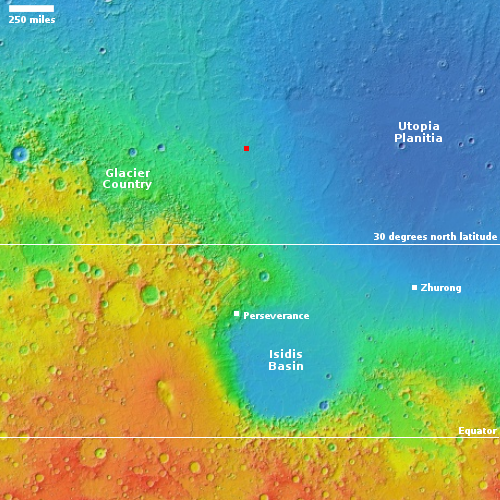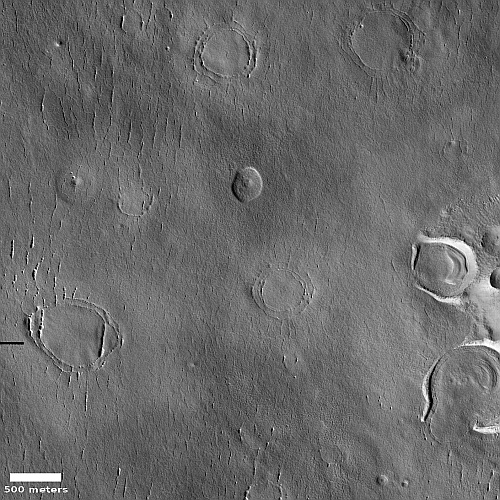Expanded craters in Martian ice
Cool image time! The photo to the right, rotated, cropped, reduced, and sharpened to post here, was taken on August 18, 2022 by the high resolution camera on Mars Reconnaissance Orbiter (MRO). It includes a wide variety of geology related to sublimating ice, including expansion cracks as well as several different examples of what scientists call “expanded craters,” impacts that occurred in near surface ice and have been reshaped by the ice’s melting and sublimation at impact and then later. It also shows some obvious glacial fill in the two distorted craters at the center right.
A 2017 dissertation [pdf] by Donna Viola of the University of Arizona outlines nicely what we know of Martian expanded craters. As she notes in her conclusion:
The age of the ice as inferred from the age of the source primary craters, on the order of tens of millions of years old, is inconsistent with the expected timescale for ice loss due to obliquity-induced climate change. The obliquity of Mars oscillates on timescales of ~100,000 years, and the stability of shallow ice should similarly fluctuate, where lower-latitude ice deposition occurs at high obliquity and migrates back to the pole during low obliquity periods. Based on the timescales of expected instability, ice should not persist in the mid-latitudes for tens of millions of years.
The age of this ice is similarly inconsistent with previous modeling efforts to quantify the thickness of dry overburden required to preserve excess ice, which suggested that ~10 m of material is required to protect 90% pure excess ice for > 10 Myr [million years], whereas our observations indicate that ice is significantly shallower (< 1 m in some places). Updated modeling that accounts for the growth of a sublimation lag and the deposition of pore ice to protect excess ice from further sublimation is in progress, and may help to explain the persistence of excess ice in Arcadia Planitia over many martian climate cycles.
To put it more simply, this ice should not remain preserved for so long, that the various climate cycles that Mars experiences due to the extreme shifts of its planetary tilt, or obliquity, should cause these features to dissipate much faster.
Viola’s dissertation focuses on the persistence of ice in Arcadia Planitia, a region of the northern lowland plains which SpaceX has chosen as its prime candidate landing site for Starship. She has also said of this region that “I think you could dig anywhere to get your water ice.”

The overview map to the right provides a wider context, and shows that Arcadia Planitia is not the only spot on Mars with evidence of such persistent near-surface ice. The red dot marks the location of this photo, at 42 degrees north latitude on the western edge of Utopia Planitia. Utopia is about 4,000 miles west of Arcadia Planitia, though at the same latitudes. Many other images in this region show similar features of expanded and distorted craters. Like Arcadia, it is very likely that you could hit ice in many places in Utopia by merely sticking a shovel in the ground.
The evidence also suggests that the closer to the pole you go, the more ice there is close to the surface. The relatively flat northern lowland plains of Mars also strongly imply the existence of a thick ice table under the ground. The ghost craters in the photo above add weight to that implication.
On Christmas Eve 1968 three Americans became the first humans to visit another world. What they did to celebrate was unexpected and profound, and will be remembered throughout all human history. Genesis: the Story of Apollo 8, Robert Zimmerman's classic history of humanity's first journey to another world, tells that story, and it is now available as both an ebook and an audiobook, both with a foreword by Valerie Anders and a new introduction by Robert Zimmerman.
The print edition can be purchased at Amazon or from any other book seller. If you want an autographed copy the price is $60 for the hardback and $45 for the paperback, plus $8 shipping for each. Go here for purchasing details. The ebook is available everywhere for $5.99 (before discount) at amazon, or direct from my ebook publisher, ebookit. If you buy it from ebookit you don't support the big tech companies and the author gets a bigger cut much sooner.
The audiobook is also available at all these vendors, and is also free with a 30-day trial membership to Audible.
"Not simply about one mission, [Genesis] is also the history of America's quest for the moon... Zimmerman has done a masterful job of tying disparate events together into a solid account of one of America's greatest human triumphs."--San Antonio Express-News
Cool image time! The photo to the right, rotated, cropped, reduced, and sharpened to post here, was taken on August 18, 2022 by the high resolution camera on Mars Reconnaissance Orbiter (MRO). It includes a wide variety of geology related to sublimating ice, including expansion cracks as well as several different examples of what scientists call “expanded craters,” impacts that occurred in near surface ice and have been reshaped by the ice’s melting and sublimation at impact and then later. It also shows some obvious glacial fill in the two distorted craters at the center right.
A 2017 dissertation [pdf] by Donna Viola of the University of Arizona outlines nicely what we know of Martian expanded craters. As she notes in her conclusion:
The age of the ice as inferred from the age of the source primary craters, on the order of tens of millions of years old, is inconsistent with the expected timescale for ice loss due to obliquity-induced climate change. The obliquity of Mars oscillates on timescales of ~100,000 years, and the stability of shallow ice should similarly fluctuate, where lower-latitude ice deposition occurs at high obliquity and migrates back to the pole during low obliquity periods. Based on the timescales of expected instability, ice should not persist in the mid-latitudes for tens of millions of years.
The age of this ice is similarly inconsistent with previous modeling efforts to quantify the thickness of dry overburden required to preserve excess ice, which suggested that ~10 m of material is required to protect 90% pure excess ice for > 10 Myr [million years], whereas our observations indicate that ice is significantly shallower (< 1 m in some places). Updated modeling that accounts for the growth of a sublimation lag and the deposition of pore ice to protect excess ice from further sublimation is in progress, and may help to explain the persistence of excess ice in Arcadia Planitia over many martian climate cycles.
To put it more simply, this ice should not remain preserved for so long, that the various climate cycles that Mars experiences due to the extreme shifts of its planetary tilt, or obliquity, should cause these features to dissipate much faster.
Viola’s dissertation focuses on the persistence of ice in Arcadia Planitia, a region of the northern lowland plains which SpaceX has chosen as its prime candidate landing site for Starship. She has also said of this region that “I think you could dig anywhere to get your water ice.”

The overview map to the right provides a wider context, and shows that Arcadia Planitia is not the only spot on Mars with evidence of such persistent near-surface ice. The red dot marks the location of this photo, at 42 degrees north latitude on the western edge of Utopia Planitia. Utopia is about 4,000 miles west of Arcadia Planitia, though at the same latitudes. Many other images in this region show similar features of expanded and distorted craters. Like Arcadia, it is very likely that you could hit ice in many places in Utopia by merely sticking a shovel in the ground.
The evidence also suggests that the closer to the pole you go, the more ice there is close to the surface. The relatively flat northern lowland plains of Mars also strongly imply the existence of a thick ice table under the ground. The ghost craters in the photo above add weight to that implication.
On Christmas Eve 1968 three Americans became the first humans to visit another world. What they did to celebrate was unexpected and profound, and will be remembered throughout all human history. Genesis: the Story of Apollo 8, Robert Zimmerman's classic history of humanity's first journey to another world, tells that story, and it is now available as both an ebook and an audiobook, both with a foreword by Valerie Anders and a new introduction by Robert Zimmerman.
The print edition can be purchased at Amazon or from any other book seller. If you want an autographed copy the price is $60 for the hardback and $45 for the paperback, plus $8 shipping for each. Go here for purchasing details. The ebook is available everywhere for $5.99 (before discount) at amazon, or direct from my ebook publisher, ebookit. If you buy it from ebookit you don't support the big tech companies and the author gets a bigger cut much sooner.
The audiobook is also available at all these vendors, and is also free with a 30-day trial membership to Audible.
"Not simply about one mission, [Genesis] is also the history of America's quest for the moon... Zimmerman has done a masterful job of tying disparate events together into a solid account of one of America's greatest human triumphs."--San Antonio Express-News


